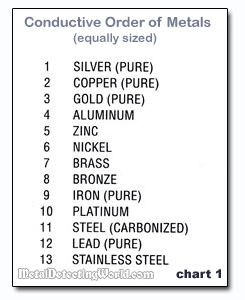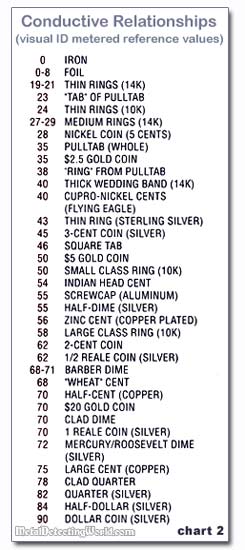Conductive Order of Metals
Conductive Relationships Charts
Conductivity is the measured amount of eddy current generation created on a metal target's surface. Contrary to popular belief, gold in its purest state is not a better conductor of electricity than pure silver. Silver is the best conductor when compared to all other metals detected with metal detectors.
It is important also to understand that basic metals take on new conductive properties when alloyed with different metals. On the Conductive Order of Metals chart 1, listed are the basic types of metals and some common alloys in order of descending conductive relationship. If you become familiar with this order, it will be of great value when making decisions on discrimination levels in the field.

In chart 2, listed is a range of targets typically found while metal detecting. Their order was derived by passing each entry across the search coil of White's Spectrum XLT - a detector equipped with visual identification and recording the corresponding 0-100 reference scale meter reading.

These numbers are listed for reference only and should not be compared to any other visual identifier. Notice on this chart where the smallest silver coins are in relationship to larger silver coins. Notice where gold coins reside in relationship to undesirable targets such as the pulltab and screw cap.
The discrimination setting used to routinely reject common trash items can actually reject some of the more desirable gold and platinum rings which are set with expensive diamonds. Detectors whose meters point to or display trash target labels, such as "pull tab" and "screw cap", should not be taken at face value in all search locations.
If the dug ratio of trash targets to good targets reduces time efficiency in the field, obviously higher levels of discrimination and target labels can be used more effectively. For those who do not have visual identifying detectors, use of notch filter discrimination can increase the efficiency in such situations.
The conductive relationships shown in the charts can be used to advantage. One should set up a discrimination level according to the targets present at the metal detecting site. It is done by setting up the discrimination level to zero and digging up several targets before deciding what setting (if any) is optimal. One should keep in mind the age of the site and the types of coins that may be present.
One example of a mistake would be using a discrimination setting which rejects the new "square tabs" just because several of them were found lying on the surface of a wooded area suspected of being a picnic grove in the 1850's. If such a place was attractive back then for picnics, it could also be attractive to people today for the same purpose.
On chart 2, you will see that a silver three-cent coin occupies the same conductive level as the square tab! Despite all the modern technological advances, "state-of-the-art" circuitry, and fancy sales rhetoric, the most accurate detector is still a shovel! In other words, "if you are not sure, dig!"
Every time we come back to the sites that we or other detectorists had searched numerous times before, we make new valuable finds. Why is this happening? There are two reasons: the winter frosts that turn the buried targets over, and the excessive usage of Discrimination - sometimes "silver coins only". Thank God, many detectorists utilize high levels of Discrimination on their metal detectors! This allows a serious treasure hunter to recover the most valuable coins and artefacts at the "hunted-out" sites. Just like there is a range of conductivities of metals, there is a range of ways of conducting the search. You decide which one is yours!